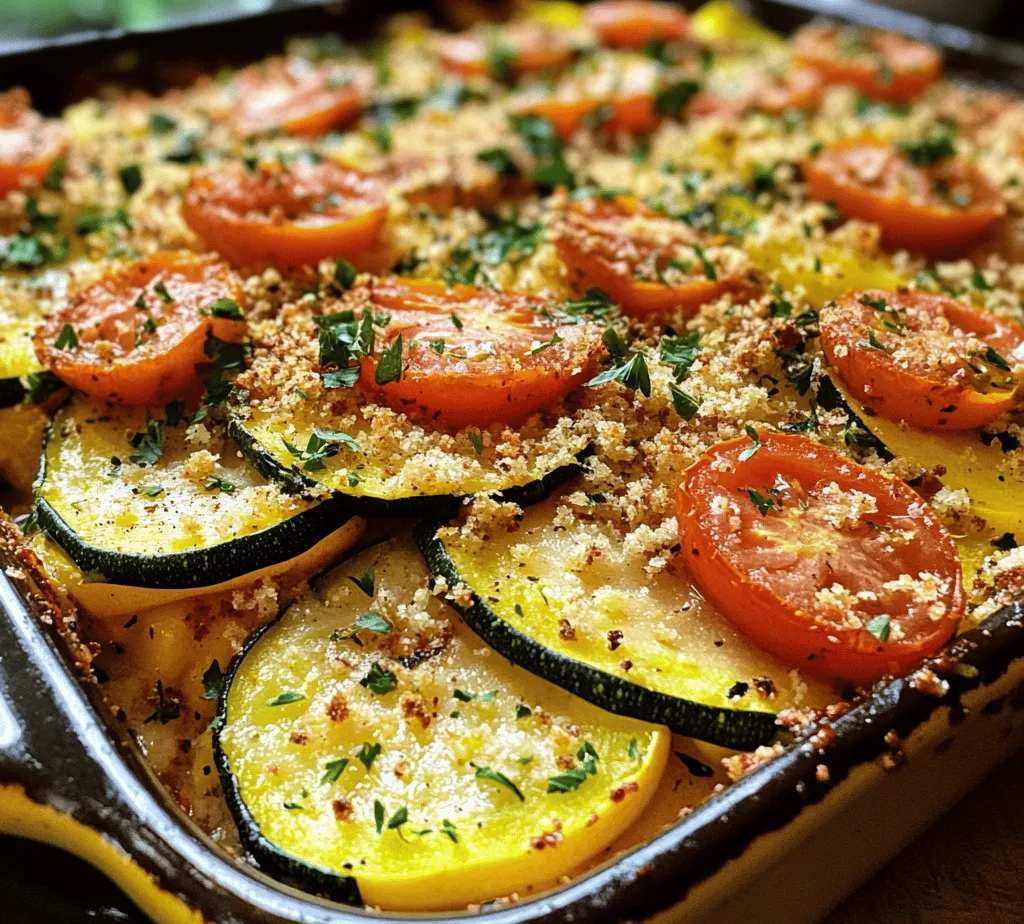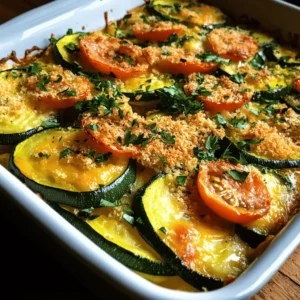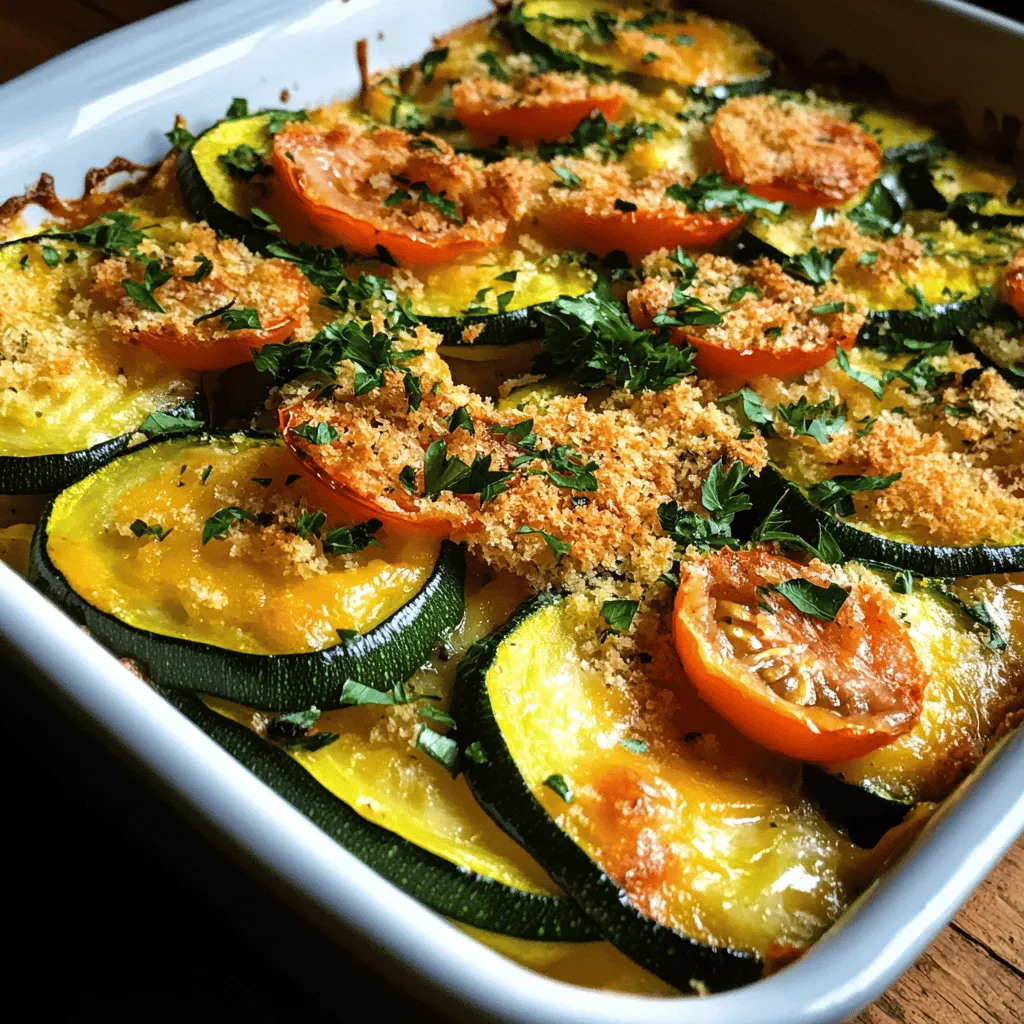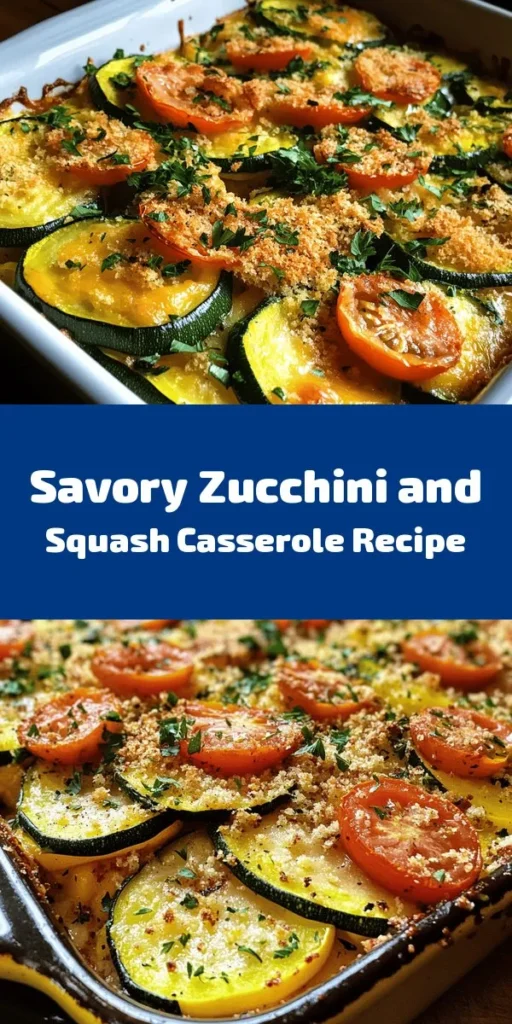Introduction
As the warmth of summer ushers in an abundance of fresh produce, there’s no better way to celebrate the season than with a hearty Zucchini and Squash Casserole. This delightful dish is not only a feast for the eyes but also a mouthwatering combination of flavors and textures that will satisfy both vegetarians and meat-lovers alike. With its creamy consistency, vibrant colors, and aromatic herbs, this casserole captures the essence of comfort food while showcasing the best seasonal vegetables.
Zucchini and squash are two of the most versatile ingredients in the kitchen. Their mild flavors and soft textures lend themselves beautifully to a variety of dishes, whether you’re grilling, roasting, or baking. By incorporating these seasonal vegetables into your meals, you can enjoy their health benefits while adding a splash of color and nutrition to your plate. Plus, casseroles are a fantastic way to prepare meals ahead of time, making them ideal for busy weeknights or family gatherings.
In this article, we’ll delve into the nutritional benefits of zucchini and squash, explore how to select the best produce, and provide a detailed ingredient breakdown that highlights each component in our Zucchini and Squash Casserole Delight. So, roll up your sleeves and get ready to whip up a dish that’s both nourishing and delicious!
The Beauty of Zucchini and Squash
Zucchini and squash are not just garden staples; they are nutritional powerhouses that can elevate your meals in both health and flavor. Zucchini, also known as courgette, is a summer squash with a mild flavor and high water content, making it an excellent choice for hydration. This vegetable is low in calories, rich in antioxidants, and packed with vitamins A and C, which are crucial for maintaining healthy skin and a robust immune system.
On the other hand, yellow squash, with its vibrant golden hue, brings a slightly sweeter taste and a firmer texture to the table. Yellow squash is also rich in vitamins and minerals, including potassium and magnesium, which are vital for heart health and muscle function. Together, zucchini and squash create a dynamic duo that not only nourishes the body but also tantalizes the taste buds.
When it comes to seasonal availability, both zucchini and squash peak during the summer months, making them affordable and easy to find at farmers’ markets and grocery stores. To select the best zucchini and squash, look for vegetables that are firm, smooth, and free of blemishes. Smaller sizes tend to be sweeter and more tender, while larger varieties may be more fibrous and less flavorful. By choosing fresh, in-season produce, you ensure that your casserole will be bursting with flavor.
These vegetables also play a significant role in enhancing the flavor and texture of dishes. Zucchini and squash absorb seasonings beautifully and can take on the flavors of other ingredients they are cooked with. When baked in a casserole, they become tender and meld seamlessly with cheese, herbs, and spices, creating a comforting dish that appeals to all palates.
Ingredients Breakdown
Now that we’ve highlighted the importance of zucchini and squash in our casserole, let’s dive deeper into the specific ingredients that will make this Zucchini and Squash Casserole Delight truly special.
Zucchini
Zucchini comes in several varieties, including green, yellow, and even striped types. Each variety has its unique flavor profile, with green zucchini being the most common. Nutritionally, zucchini is low in calories and rich in dietary fiber, which aids digestion. It also contains essential vitamins and minerals such as vitamin K, vitamin C, and folate. When preparing your casserole, slice the zucchini into thin rounds for even cooking and optimal flavor absorption.
Yellow Squash
Similar to zucchini, yellow squash is available in both straight and crookneck varieties. The sweet, buttery flavor of yellow squash adds a delightful contrast to the mild taste of zucchini. It is also a good source of vitamins A and C, and its unique bright color adds visual appeal to the casserole. Slice the yellow squash in a manner similar to zucchini to ensure they cook evenly together.
Onion and Garlic
Onion and garlic are the aromatic foundations of many savory dishes, and our casserole is no exception. Onions provide a sweet and savory base that enhances the overall flavor of the dish, while garlic adds a fragrant punch. Both ingredients are rich in antioxidants and have numerous health benefits, including anti-inflammatory properties. Sautéing the onion and garlic before adding them to the casserole brings out their natural sweetness and ensures a rich flavor profile.
Cherry Tomatoes
Adding cherry tomatoes to the casserole introduces a burst of brightness and acidity that balances the creaminess of the dish. These small, juicy tomatoes are packed with vitamins C and K, as well as lycopene, an antioxidant linked to various health benefits. Halve the cherry tomatoes and mix them into the casserole for a pop of color and flavor.
Cheese Selection
Cheese is a key ingredient in creating the creamy, indulgent texture that makes casseroles so comforting. For this recipe, consider using shredded cheddar cheese for its sharp flavor or mozzarella for a milder taste. If you’re looking for a dairy-free alternative, vegan cheeses made from nuts or soy can provide a similar creamy texture without the dairy. The choice of cheese will ultimately influence the overall flavor of the casserole, so choose one that aligns with your taste preferences.
Milk or Cream
To achieve that luxurious, creamy texture, milk or cream is essential. Whole milk will provide a rich consistency, while heavy cream will make the casserole extra decadent. For a lighter version, you can opt for low-fat milk or a plant-based milk alternative, such as almond or oat milk. The key is to combine the milk with the eggs to create a custard-like base that binds the ingredients together.
Eggs
Eggs serve as an important binding agent in this casserole, adding protein and helping to hold everything together. They contribute to the overall texture, making the dish hearty and satisfying. Be sure to whisk the eggs well and mix them with the milk before adding them to the vegetable mixture for an even distribution.
Herbs and Seasonings
To elevate the flavors of your Zucchini and Squash Casserole, fresh or dried herbs are a must. Oregano and basil are classic choices that complement the sweetness of the vegetables beautifully. Add these herbs to the vegetable mixture before baking, ensuring they infuse their flavors into the dish. Additionally, a sprinkle of salt and pepper will enhance the overall taste, allowing the natural flavors of the zucchini and squash to shine.
Breadcrumbs
For the finishing touch, breadcrumbs provide texture and crunch to the casserole. They create a delightful contrast to the creamy filling and can be seasoned to add even more flavor. Use panko breadcrumbs for a lighter, airier topping or traditional breadcrumbs for a heartier crunch. You can also mix in some grated Parmesan cheese with the breadcrumbs for an extra layer of flavor.
Olive Oil
Finally, a drizzle of olive oil is essential for sautéing the onions and garlic, as well as adding richness to the casserole. Olive oil is a healthy fat that contains monounsaturated fats, which are beneficial for heart health. It also adds depth of flavor to the dish. When choosing an olive oil, opt for extra virgin for its superior taste and nutritional properties.
As we prepare to dive into the step-by-step instructions for creating this Zucchini and Squash Casserole Delight, remember that the quality of your ingredients plays a significant role in the final outcome. By selecting fresh, seasonal vegetables and high-quality products, you can create a dish that is not only delicious but also nourishing. Stay tuned for the next section where we will guide you through the cooking process.

Preparation Steps
Preheating the Oven: Importance of Proper Temperature
Preheating your oven to the correct temperature is a critical step in ensuring your Zucchini and Squash Casserole Delight turns out perfectly. For this recipe, preheat your oven to 375°F (190°C). This temperature allows the casserole to cook evenly while achieving that beautiful golden-brown top. If you skip this step, your casserole may not cook properly, resulting in uneven textures and flavors. A properly preheated oven ensures that the cooking process begins the moment you place the casserole inside, allowing for optimal flavor development.
Sautéing Vegetables: Techniques for Optimal Flavor Extraction
The next step is to sauté your vegetables, which serves as the flavor foundation of your casserole. Begin by heating a couple of tablespoons of olive oil in a large skillet over medium heat. Once the oil is shimmering, add finely chopped onions and minced garlic. Sauté these for about 2-3 minutes until they become translucent and fragrant.
Next, add your sliced zucchini and yellow squash. Sauté the vegetables for about 5-7 minutes, stirring frequently. This technique not only enhances the vegetables’ natural sweetness but also helps to reduce their moisture content, preventing a watery casserole. Season with salt and pepper while sautéing to amplify the flavors. If you want to take it a step further, consider adding a pinch of red pepper flakes for a hint of heat or fresh herbs like thyme or oregano for added depth.
Combining Ingredients: Tips for Achieving the Right Consistency
Once your vegetables are perfectly sautéed, it’s time to combine them with the other ingredients. In a large mixing bowl, combine the sautéed zucchini and squash with beaten eggs, shredded cheese (like mozzarella or cheddar), and breadcrumbs. Mixing these ingredients together should result in a thick, cohesive mixture.
To ensure the right consistency, be mindful of the amount of breadcrumbs you add. They should act as a binder, not overwhelm the dish. If you find the mixture too dry, add a splash of milk or vegetable broth to reach the desired consistency. This step is essential, as it provides the binding necessary to keep the casserole intact when served.
Layering the Casserole: Presentation and Texture Considerations
For an appealing presentation, layering is key. Begin by greasing a baking dish with a little olive oil or cooking spray. Pour the combined mixture into the dish and spread it evenly. To create texture, consider topping the casserole with additional shredded cheese and a sprinkle of breadcrumbs mixed with a bit of olive oil. This not only adds flavor but also creates a delightful crunch on top.
For a more colorful and visually appealing dish, you can alternate layers of zucchini and squash with layers of the mixture. This technique provides a beautiful presentation that highlights the vibrant colors of the vegetables, making your casserole not only delicious but also a feast for the eyes.
Baking to Perfection
Importance of Baking Time and Temperature
Once your casserole is layered and ready, place it in the preheated oven. Bake for approximately 30-35 minutes at 375°F (190°C). This time allows the flavors to meld together while the cheese melts and the top becomes golden brown. The key to a perfect casserole is monitoring both time and temperature; undercooking can leave you with a mushy texture, while overcooking can dry it out.
Visual Cues for Doneness: How to Tell When the Casserole is Ready
As the baking time approaches its end, keep an eye on your casserole. It’s ready to come out of the oven when the top is golden brown, and the edges are bubbling. A good test is to insert a toothpick into the center; it should come out clean or with only a few moist crumbs. If you see a lot of liquid, let it bake for an additional 5-10 minutes, checking frequently to avoid over-baking.
The Science Behind Bubbling and Browning
The bubbling you see around the edges of your casserole is a good sign that it’s cooking properly. This bubbling indicates that moisture is being released from the vegetables, and the cheese is melting and binding everything together. Browning occurs due to the Maillard reaction, where proteins and sugars in the cheese and breadcrumbs undergo a chemical reaction at high heat, creating complex flavors and a delicious crust. Understanding these processes can help you become more adept at baking casseroles and other dishes.
Serving Suggestions
Ideal Accompaniments for the Casserole
The Zucchini and Squash Casserole Delight is wonderfully versatile and pairs well with various side dishes. For a balanced meal, consider serving it alongside a fresh green salad drizzled with a light vinaigrette. The crispness of the salad complements the richness of the casserole beautifully. Additionally, roasted chicken or grilled fish can round out the meal, making it satisfying and nutritious.
Creative Serving Ideas for Family Gatherings or Meal Prep
If you’re preparing for a family gathering, consider serving the casserole in individual ramekins. This not only adds a touch of elegance but also makes it easier for guests to serve themselves. Alternatively, if you’re meal prepping, this casserole can be portioned into airtight containers, making it an excellent grab-and-go option for lunches throughout the week. Just reheat in the microwave or oven for a quick meal that’s both comforting and delicious.
Garnishing with Parsley: Enhancing Presentation and Flavor
For an extra touch, garnish your casserole with freshly chopped parsley before serving. This not only adds a pop of color but also enhances the overall flavor profile. The freshness of the parsley cuts through the richness of the cheese and adds an aromatic element to each bite. A sprinkle of freshly cracked black pepper can also elevate the dish, providing a bit of heat and enhancing the overall presentation.
Health Considerations
Tips for Making the Recipe Healthier (e.g., Low-Fat Alternatives)
While this Zucchini and Squash Casserole is already a healthy option, there are several ways to make it even more nutritious. Consider using low-fat cheese options to reduce the calorie count without sacrificing flavor. Greek yogurt can be used in place of sour cream or cream cheese for a creamy texture while adding protein and probiotics.
You can also increase the vegetable content by adding other nutrient-rich ingredients such as spinach, kale, or bell peppers. These additions not only enhance the nutritional profile but also contribute to a more colorful and vibrant dish.
Dietary Adaptations for Gluten-Free or Dairy-Free Diets
For those following a gluten-free diet, simply swap out the regular breadcrumbs for gluten-free alternatives made from rice or almond flour. If you need to make the dish dairy-free, use plant-based cheese alternatives or omit the cheese entirely, replacing it with a mixture of blended cashews or nutritional yeast to achieve a cheesy flavor without the dairy.
Portion Control and Serving Sizes
When serving this casserole, be mindful of portion sizes, especially if you’re watching your calorie intake. Consider using a measuring cup to serve out portions to keep servings consistent. Generally, a serving size of casserole is about 1 cup, which can provide a satisfying amount while allowing room for a healthy side dish.
Conclusion
The Zucchini and Squash Casserole Delight stands out as a wholesome dish that combines the freshness of seasonal vegetables with comforting flavors. This recipe not only highlights the versatility of zucchini and squash but also serves as a canvas for your culinary creativity. Whether you enjoy it as a side dish or as part of a main meal, this casserole is sure to impress family and friends with its rich flavors and appealing presentation.
Don’t hesitate to experiment with variations based on your personal tastes. You can incorporate different vegetables, add spices, or even include proteins like chicken or beans for added heartiness. The joy of cooking lies in creativity, and this casserole allows for endless possibilities.
Embrace the pleasure of cooking with fresh, seasonal ingredients and enjoy the satisfying results that come from preparing a meal that is both delicious and nourishing. Your Zucchini and Squash Casserole Delight is not just a recipe; it’s a celebration of the flavors of the season and the joy of sharing meals with loved ones.



